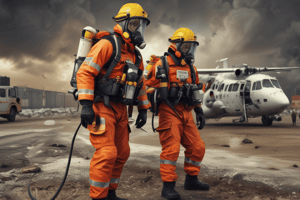Podcast
Questions and Answers
What is the primary objective of this lesson plan?
What is the primary objective of this lesson plan?
- To provide overall knowledge of hazardous materials to the community
- To educate the public about hazardous materials
- To train emergency response personnel to respond to hazardous materials emergencies (correct)
- To identify the locations where hazardous materials may be found
What is the significance of Benner's D.E.C.I.D.E. process?
What is the significance of Benner's D.E.C.I.D.E. process?
- It's a classification system for hazardous materials
- It's a procedure for handling hazardous materials
- It's a response procedure for emergency response personnel (correct)
- It's a protocol for identifying hazardous materials
What is the significance of the 'meaning of the term 'hazardous material''?
What is the significance of the 'meaning of the term 'hazardous material''?
- To understand the definition of hazardous materials (correct)
- To understand the function of emergency response personnel in hazardous materials emergencies
- To understand the categories and classifications of hazardous materials
- To identify the potential hazards presented by various types of hazardous materials
What is the primary concern of the community regarding hazardous materials?
What is the primary concern of the community regarding hazardous materials?
What is the role of emergency response personnel trained to the awareness level?
What is the role of emergency response personnel trained to the awareness level?
What is the purpose of identifying the potential sources of information and assistance available to first response personnel?
What is the purpose of identifying the potential sources of information and assistance available to first response personnel?
What do the six steps in Benner's D.E.C.I.D.E. process entail?
What do the six steps in Benner's D.E.C.I.D.E. process entail?
Why is it important for first responders to understand the U.S. Department of Transportation categories and classifications of hazardous materials?
Why is it important for first responders to understand the U.S. Department of Transportation categories and classifications of hazardous materials?
What is the definition of hazardous materials according to the Secretary of Transportation?
What is the definition of hazardous materials according to the Secretary of Transportation?
How many classes of hazardous materials are defined by the U.S. Department of Transportation?
How many classes of hazardous materials are defined by the U.S. Department of Transportation?
What is the purpose of breaking down hazardous materials into classes and categories?
What is the purpose of breaking down hazardous materials into classes and categories?
What is a common hazard associated with Class 1 materials?
What is a common hazard associated with Class 1 materials?
What is a common hazard associated with Class 8 materials?
What is a common hazard associated with Class 8 materials?
What is the main purpose of the 'Emergency Response Guidebook'?
What is the main purpose of the 'Emergency Response Guidebook'?
What is the first step in managing hazardous materials?
What is the first step in managing hazardous materials?
What is the purpose of recognizing where hazardous materials are stored in a community?
What is the purpose of recognizing where hazardous materials are stored in a community?
What is the purpose of the ORM-D classification?
What is the purpose of the ORM-D classification?
What is a common hazard associated with Class 3 materials?
What is a common hazard associated with Class 3 materials?
How many steps are involved in managing hazardous materials?
How many steps are involved in managing hazardous materials?
What is the primary purpose of CHEMTREC?
What is the primary purpose of CHEMTREC?
Who should the driver contact during a hazardous materials incident?
Who should the driver contact during a hazardous materials incident?
What is the purpose of dividing recruits into response teams during a training scenario?
What is the purpose of dividing recruits into response teams during a training scenario?
What resource will recruits be required to use during a training scenario?
What resource will recruits be required to use during a training scenario?
What is the benefit of having access to resources during a training scenario?
What is the benefit of having access to resources during a training scenario?
What type of agencies may be contacted during a hazardous materials incident?
What type of agencies may be contacted during a hazardous materials incident?
What is the nickname given to law enforcement as part of the first responder team to hazardous material or chemical spills?
What is the nickname given to law enforcement as part of the first responder team to hazardous material or chemical spills?
What is the purpose of first responders trained at the awareness level?
What is the purpose of first responders trained at the awareness level?
What is the first step in the Benner's D.E.C.I.D.E. process?
What is the first step in the Benner's D.E.C.I.D.E. process?
What is the primary goal of the Benner's D.E.C.I.D.E. process?
What is the primary goal of the Benner's D.E.C.I.D.E. process?
Why are hazardous materials a concern in the community?
Why are hazardous materials a concern in the community?
What is the purpose of the 'Evaluate' step in the Benner's D.E.C.I.D.E. process?
What is the purpose of the 'Evaluate' step in the Benner's D.E.C.I.D.E. process?
What is one of the potential outcomes associated with an emergency created when hazardous materials are present?
What is one of the potential outcomes associated with an emergency created when hazardous materials are present?
What is one of the areas that first responders at the awareness level should be trained to demonstrate competency in?
What is one of the areas that first responders at the awareness level should be trained to demonstrate competency in?
What is the purpose of the 'Do' step in the Benner's D.E.C.I.D.E. process?
What is the purpose of the 'Do' step in the Benner's D.E.C.I.D.E. process?
Where are hazardous materials commonly found in the community?
Where are hazardous materials commonly found in the community?
What is a common route for hazardous materials transportation?
What is a common route for hazardous materials transportation?
What is a key indicator of a hazardous materials event?
What is a key indicator of a hazardous materials event?
What is the purpose of a DOT identification number?
What is the purpose of a DOT identification number?
What is indicated by a United Nations hazard class number of 3?
What is indicated by a United Nations hazard class number of 3?
What is a key resource for first responders to identify hazardous materials?
What is a key resource for first responders to identify hazardous materials?
What information is required to be included on shipping papers?
What information is required to be included on shipping papers?
What is indicated by a packing group of PG I?
What is indicated by a packing group of PG I?
What is the purpose of an emergency response telephone number?
What is the purpose of an emergency response telephone number?
What is an additional notation that may be included on shipping papers?
What is an additional notation that may be included on shipping papers?
What is a key skill for first responders in identifying hazardous materials?
What is a key skill for first responders in identifying hazardous materials?
Flashcards are hidden until you start studying
Study Notes
Hazardous Materials
- Definition: A substance or material that poses an unreasonable risk to health, safety, and property when transported in commerce.
- Includes: Hazardous substances, hazardous wastes, marine pollutants, elevated temperature materials, and materials designated as hazardous in the Hazardous Materials Table.
U.S. Department of Transportation Categories and Classifications
- Class 1: Explosives
- Class 2: Compressed Gases
- Class 3: Flammable and Combustible Liquids
- Class 4: Flammable Solids; Spontaneously Combustible Materials; and Dangerous When Wet Materials
- Class 5: Oxidizers and Organic Peroxides
- Class 6: Poisonous Liquids and Solids; Etiologic or Infectious Materials
- Class 7: Radioactive Materials
- Class 8: Corrosive Materials
- Class 9: Miscellaneous Hazardous Materials
- ORM-D: Other Regulated Materials (Consumer Commodities)
Hazards Presented by Hazardous Materials
- Class 1: Blast Overpressure, Shock Waves, Flying Debris, Spreading of Fire
- Class 2: Materials Stored Under Pressure, Inhalation Hazard, Suffocation, BLEVE
- Class 3: Fire, Combustion Explosion, Water Contamination
- Class 4: Water or Moist Air Reactivity, Corrosivity, Materials Involved in Fire Will Burn Very Hot
- Class 5: Temperature and Shock Sensitivity, Ability to React Violently with Organic Materials
- Class 6: Contamination of Environment and Persons, Inhalation Hazard, Disease in Humans and Animals
- Class 7: Contamination, Radiation Burns and Sickness
- Class 8: Chemical Burns Due to Corrosive Nature, Splatter in Contact with Water
- Class 9: Burns from Elevated Temperature Materials, Contamination of Environment and Persons
- ORM-D: Poison Ingestion Hazard, Chemical Burns, Fires
First Responder Role and Responsibilities
- First responders trained at the awareness level: Recognize hazardous materials, initiate emergency response sequence, and notify authorities.
- First responders' responsibilities: Prevention, Preparedness, Response, and Recovery.
Benner's D.E.C.I.D.E. Process
- Detect hazardous material presence
- Estimate likely harm
- Choose response objectives
- Identify action options
- Do the best option
- Evaluate process
Detecting Hazardous Materials
- Clues to detect hazardous materials: Occupancy/location of incident, container type or shape, identification number or markings, senses (sight, sound, smell, touch, taste).
- Shipping papers: Carried with hazardous material shipment, contains information on material, hazard class, identification number, and emergency response telephone number.
Sources of Information and Assistance
- CHEMTREC: 24/7 access for immediate hazard and response information.
- Dispatchers and other first responders as resources.
- Transportation industry contacts and federal agencies.
- Emergency Response Guidebook, material safety data sheet (MSDS), and other information sources.
Studying That Suits You
Use AI to generate personalized quizzes and flashcards to suit your learning preferences.




